| Highways, Byways, And Bridge Photography |
Wakota Bridge
Wakota Bridge Construction
South Saint Paul, MN to Newport, MN
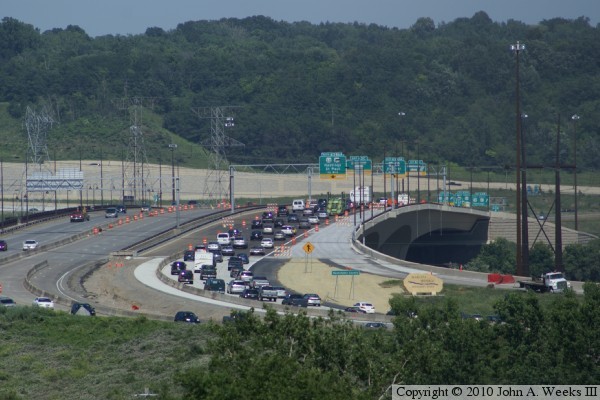
|
• Structure ID: |
NBI: 82855 (Eastbound), 82856 (Westbound). |
|
• Location: |
River Mile 832.40. |
|
• Highway: |
Interstate I-494. |
The old Wakota Bridge was been a southeast
metro area landmark since it was built. While the bridge was still sound,
it was simply overwhelmed by traffic, with significant backups many hours
each day. The new bridge combined with the US-61 freeway upgrade will
dramatically improve quality of life for anyone who has to commute
through that area. For example, the old bridge had 2 lanes in each
direction, while the new bridge will have 5 lanes on each span. In fact,
this will be the widest bridge in the state when it is completed. The
new I-35W bridge was shown in early plans to be wider than the Wakota
Bridge, but as built, the I-35W bridge ended up 4 feet narrower than
the combined Wakota Bridge spans.
The new bridge will also include a bicycle path. This will improve the
bicycle trail connections in the east metro area given that there are no
other bicycle river crossings in that area.
The plan was to build the westbound span just north of the old bridge.
All I-494 traffic would be moved to the new span, and then the old
span would be imploded. Due to the large volume of barge traffic,
the old bridge would have to be removed during the winter off season for
navigation. Once the old bridge was gone, the eastbound span of the
new bridge would be built.
The westbound span was built like a huge teeter-totter. Several piers
were erected, and the bridge structure was built both directions from
each pier. Construction crews had to be careful to build the same
amount on both sides of a pier to keep the structure in balance. Once
the bridge sections made connection with each other, the delicately
balanced sections would join to create a very strong bridge. The west
end was especially tricky to built. First, there are two interchanges
very close to the bridge that had to remain open. Next, the I-494 highway
was in the way and had to be moved south a dozen feet. And then there
is an active railroad and a street that intersect directly under the
bridge, both of which had to remain open. That section of the bridge
was supported with steel falsework.
The bridge project was cruising right along, until MN-DOT noticed that
the new bridge was starting to crack. In fact, it was in danger of
collapsing under its own weight. It turns out that the bridge designer
made a key mistake and underestimated the amount of steel rebar that
needed to be installed in the bridge. This caused the edges of the
bridge to droop a bit, and the extra stress was cracking the concrete.
Construction was shifted into low gear until a solution was found.
That solution was two fold. First, the design was modified so all
remaining construction had enough rebar. Second, the already built section
was retrofit with a number of steel cables under high tension. The cables
pulled the sides of the bridges together. The weight of the sides pulled
the cable tight, which caused the cable to push down on the stronger center
back bone of the span. This transferred the weight off of the sides, stopped
them from drooping, and reduced the stress on the concrete. Engineers say
it will not impact the life of the bridge, but only time will tell for sure.
The net result of the project is that the new bridge was not ready for
the winter of 2005/2006, so the old bridge could not be removed until
the winter of 2006/2007. That pushed the completion of the second span
back to the fall of 2008.
Note—yet another problem with the Wakota Bridge project. MN-DOT
and Lunda Construction were unable to agree on a price for building the
eastbound span over the Mississippi River. As a result, MN-DOT canceled
the contract with Lunda, and has decided to rebid the bridge. Lunda will
complete its current work and remove the old bridge. It may take as long
as a year to rebid the bridge, pushing the completion out to 2009 or 2010.
Note—yet more problems. First, it appears that Lunda was correct
in their estimate of $60-million to build the second span, and that Lunda
will receive about $10-million in a breach of contract settlement. MN-DOT
has about $40-million left to finish the project, which puts the second
span in danger of being delayed years to find the additional funding.
Second, MN-DOT is concerned about a cash flow problem related to the new
I-35W bridge. The money is needed early in the project to pay the
contractors as they go, but the federal money is not available until
later in the project when the bridge is substantially complete. One
solution is to raid the Wakota Bridge money to keep I-35W moving, and
delay the Wakota Bridge until the funding can be replaced. As a result,
one wonders if the second span will ever be built.
As of January 2008, MN-DOT has requested and opened bids for the second
span. The low bidder is, not surprisingly, Lunda Construction of Black
River Falls, WI. Their $60-million bid is within a few hundred thousand
dollars of their earlier bid that resulted in them being fired from the
project. Construction on the second span has started as of March, 2008.
Update—in November 2008, MN-DOT announced that they will recover
$20-million from the bridge designer to compensate for the design errors.
This $20-million will cover the $19.6-million cost to fix the westbound span,
and leave a few dollars left to contribute towards the $30-million price
increase to build the eastbound span. The increased cost of the westbound
span is due partly to the new design being more complex and costly to build,
and partly due to price increases during the construction delay.

The photo above is a profile view of the new westbound span. The bridge has
three main piers, two of which are located in the river, and one is located on
the edge of the river. The photo below is a view of the main channel span of
the new westbound span after the old bridge has been totally removed.

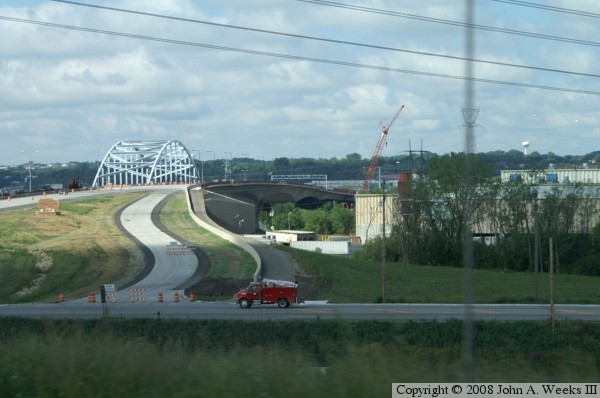
The photo above an overview of the Wakota Bridge project looking west. The
westbound span of the new bridge is only days away from opening. The blue
metal arch is the old Wakota Bridge, which is just south of the new span, and
sits where the new eastbound bridge will be located. The photo below is a
view of the construction project in 2005 about a year before the completion of
the westbound span. The old bridge, just to the left of the new bridge, is
still in use.


These two photos show work being done at the north end of the new westbound
span. If you look closely, you can see that the various spans are not
completed yet. There are gaps between the bridge spans. This is due to
the method of casting the bridge spans in place, and moving the forms
outward a section at a time. Engineers have to be careful to keep both
sides of a span in balance over the supporting pier.

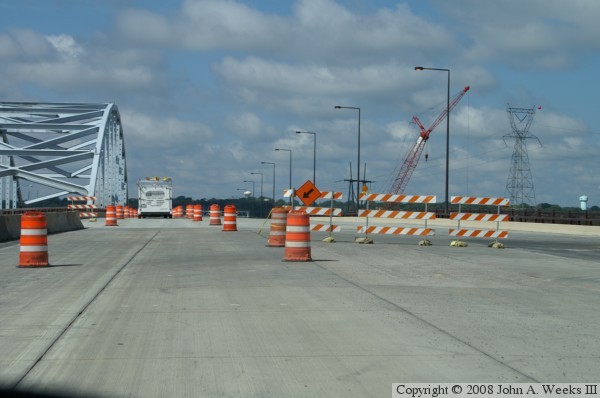
When first opened, the new westbound span was used for an entrance ramp
to the I-494 freeway. These two photos show a typical bridge crossing.
The photo below is an example of the concrete cracking that nearly
derailed the project. The cracks have been filled with industrial
epoxy. That seals the concrete, but is not a structural fix.
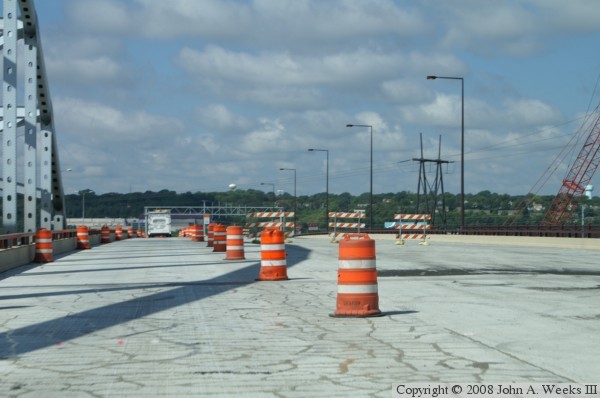

The photo above is the third of three views crossing the new westbound
span when it was open to a single lane of traffic. The photo below
is a view of the north end after much of the supporting steel and the
large construction crane were removed.
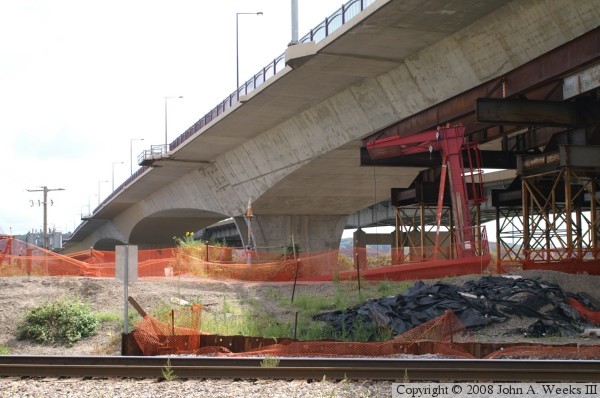

The photo above is another view of the project from 2005. This view
shows the two bridges and highway I-494. MN-DOT amazingly was able to
keep 4 lanes of traffic moving during the entire project. The photo
below is from the late summer of 2008. Work is underway on the eastern
pier of the second span. The barge is supporting pile driving for the
mid-river pier, and construction of a cofferdam using sheet pile.
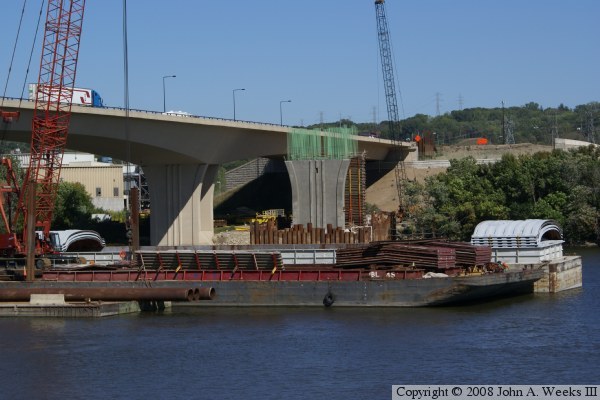
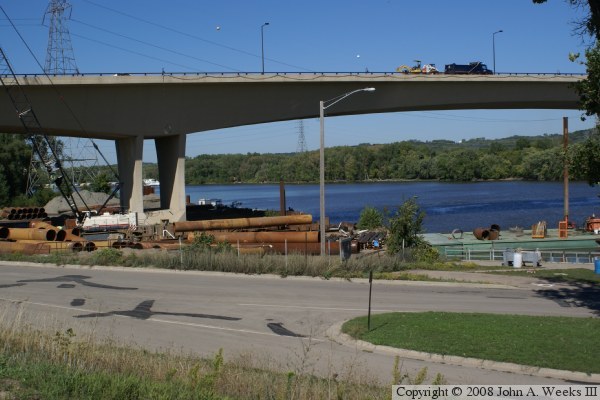
The photo above is a view of the construction of the western main span pier.
Pile driving is complete, and foundations are being poured. The photo below
is a view from the highway deck looking east on the east end of the first
span. The bridge over US-61 was recently completed, making for the lane
shift from the first span to the new eastbound lanes.


These two photos are views from November, 2008. Work on the eastern pier
is complete, and the first segment of the bridge span is being constructed.
The pile driving is nearly complete on the mid-river pier, and the western
main span pier is underway.
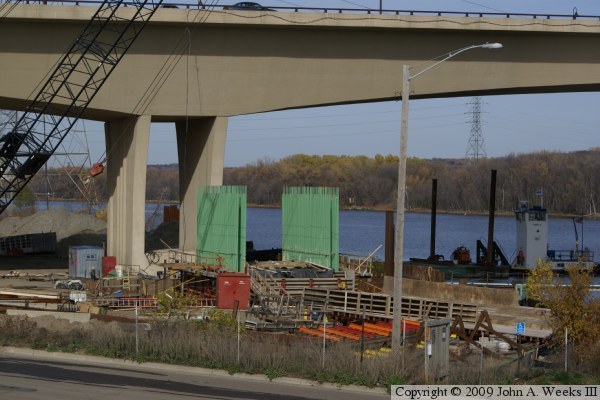
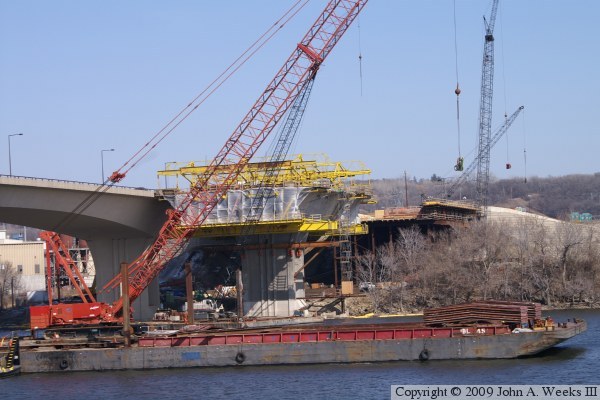
These two photos, and the four that follow, were taken in the early spring
of 2009. The bridge piers are well underway. In the eastern pier is complete,
and large yellow machines called form travelers are working outward in each
direction to cast the bridge in place. Once the form travelers have finished
a section on each side of the pier, they move outward in both directions and
cast two more sections. This works as long as they keep the bridge balanced
on the pier. Steel falsework is used to support the forms being used to
cast the very far easternmost section of the bridge. Below, we see that
temporary metal scaffolding is used to support the forms being used to
cast the first section of the span above this pier.

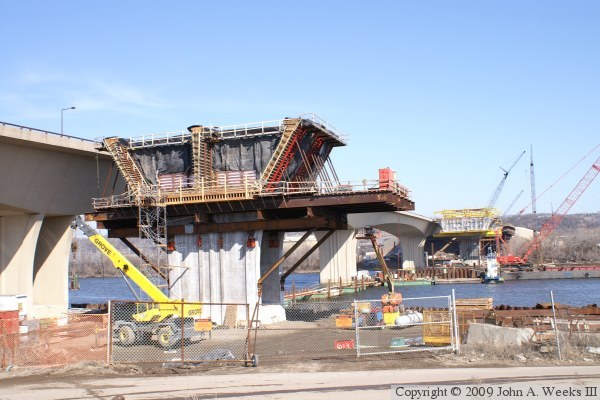
These two photos are views of the progress on the two river spans. The
first and third piers are finished. The first section of the bridge span
is being cast in place above the nearest pier, while the yellow metal
form travelers are in place on the far pier. The mid-channel pier is
just getting started. A cofferdam has been constructed with sheet pile
to allow work to continue on the river bed. A temporary bridge has been
built out the the work barges in the middle of the river. The photo above
shows the temporary bridge leading to the mid-river pier, while the photo
below shows the cofferdam and work barge.


The photo above is the finished pier near the western end of the bridge.
While the other piers are formed from two parallel concrete walls, this pier
is made of solid concrete. The photo below shows the steel falsework that
will be used to support the forms used to cast the western end of the bridge.
Building the falsework is complicated by having an active railroad line
and a street run under this span, both of which must remain open during the
project.
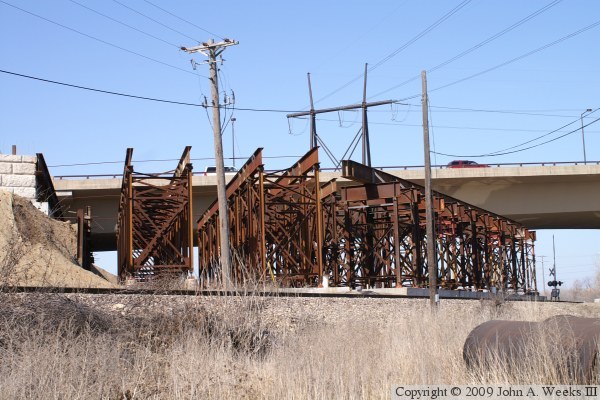

These two photos, and the six that follow, are views from two weekends in
February, 2010, as the main bridge spans were nearing completion. The photo
above is a view of main river spans. Form travelers are working to fill in
the last two gaps in the spans. The photo below is a closer view of the
western main river span two weeks later after much of the snow has melted
and the ice has gone out on the Mississippi River.
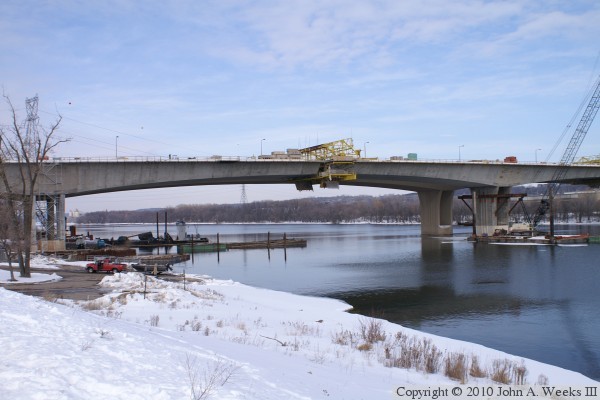

The photo below is a closer view of the eastern of the two river span, while
the photo below is a close view of the form traveler on the western of the
two river spans. In addition to supporting the forms, the form traveler also
supports scaffolding to allow workers to have access to the underside of the
bridge.
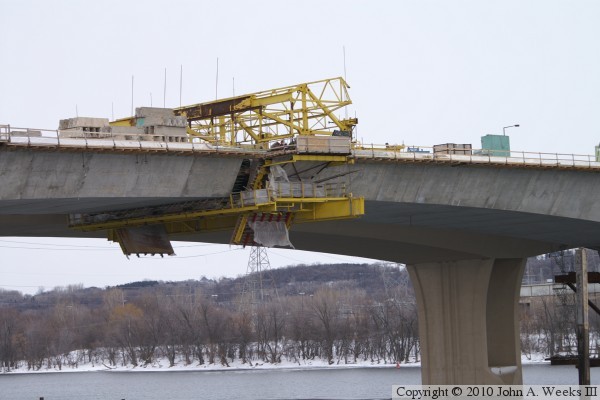
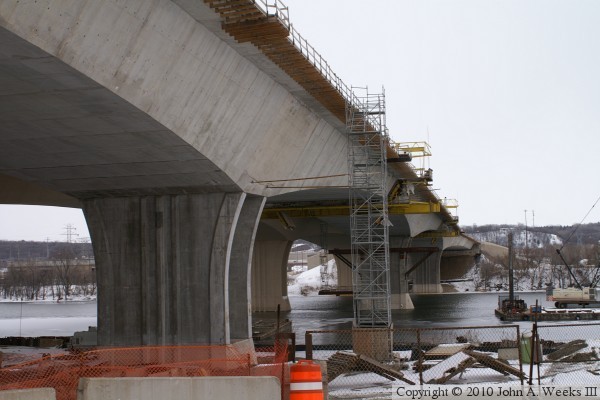
These two photos are looking east across the Mississippi River along the
downstream eastbound span of the Wakota Bridge. These two photos are taken
two weeks apart. Note that much of the snow has melted in the photo below,
and the ice is gone from the river. In either case, construction moves
forward at full speed year around despite the cold weather.

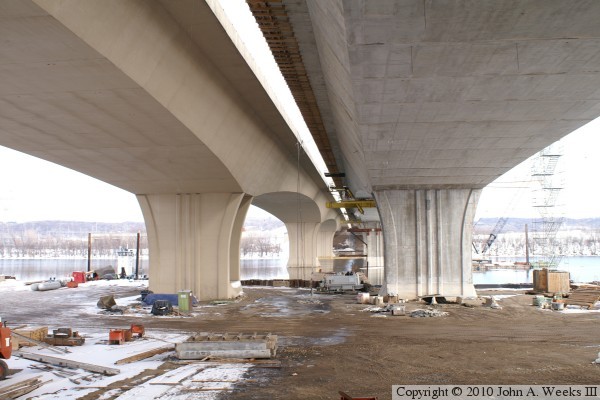
These two photos are taken from nearly the same spot on the levee directly
under and between the two bridge spans on the west side of the Mississippi
River. The photo above is a wide show of the construction site, while the
photo below is a close view looking across the river. The completed westbound
span is on the left, and the nearly completed eastbound span is on the right.
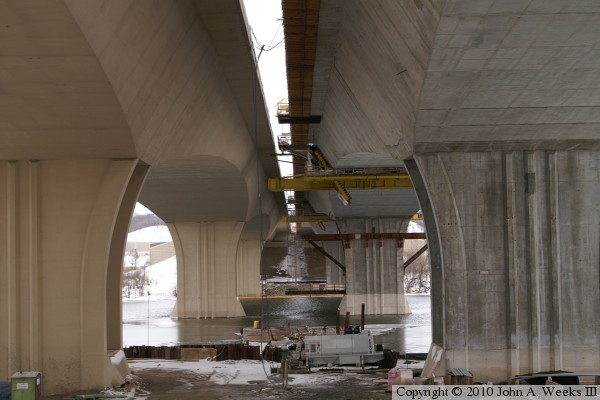
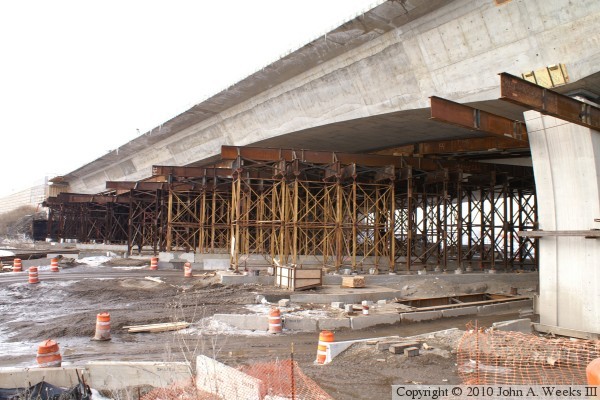
The photo above is a view of the falsework on the west end of the westbound
bridge span. This late February view shows that crews have already removed
one row of steel supports. The photo below, taken 2 weeks earlier, shows
the public road that runs through the bridge project. This was a very tight
fit.
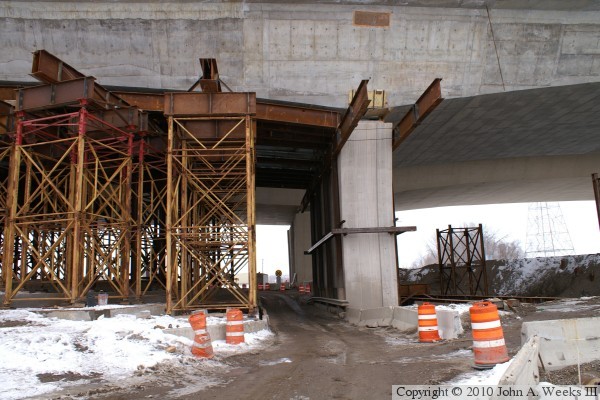
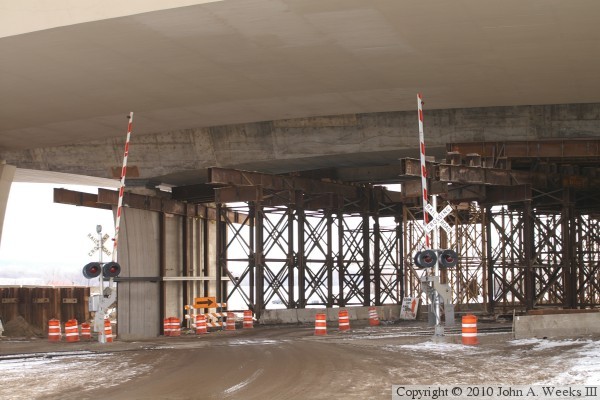
In addition to a public road running through the falsework, the photo above
shows that a railroad line also passed through the falsework. In fact, the
railroad and the road intersected directly under the westbound span. The
photo below shows a southbound Union Pacific train passing through the
steel falsework.
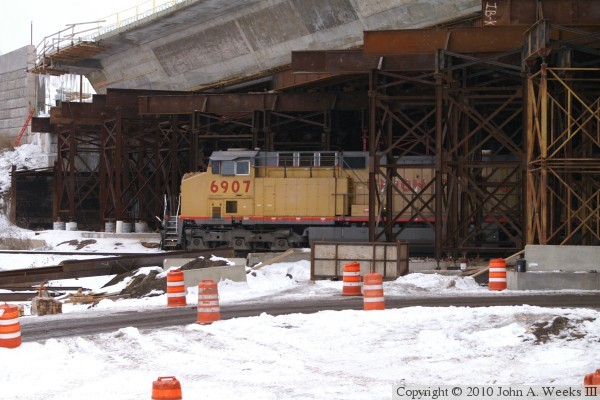
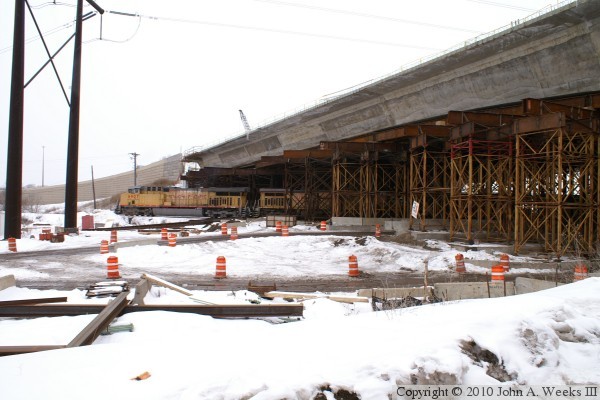
The photo above is a wider view of the falsework at the west end of the
bridge as a Union Pacific train passes southbound through the construction
project. The photo below is a view from under the bridge spans as the
train is passing southbound. This train was a coal unit train with
approximately 60 empty hoppers. This illustrates the potential for disaster
in such a project. Any mistake or loss of awareness could put a worker in
the path of a train or cause a derailment, possibly taking out the support
steel causing the bridge to collapse.

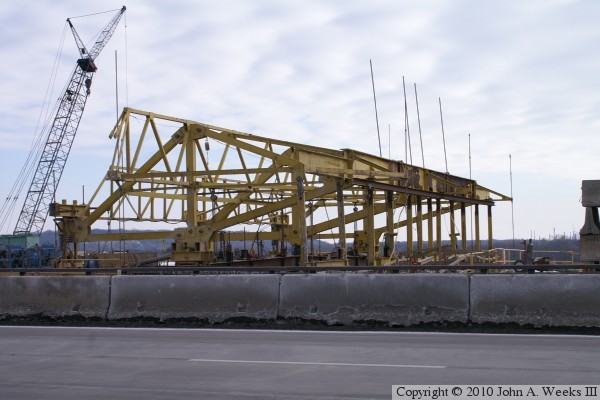
These two photos, and the two that follow, are views of one of the form
traveler machines that was used to build the bridge. The main bridge spans
were started at 3 large piers. Once the piers were built, the bridge was
built outwards in each direction from each pier. The trick was to keep the
structure on each side of each pier balanced so it would not tip over. The
bridge was built outwards using these form travelers. They would attach to
an already built section of the bridge, and hold the concrete forms in place
to build the next section. They also held the scaffolding for the work crews.
These machines are adjustable to allow the bridge to be built thinner as the
span gets further from the piers. The photo above is looking southwest
across the westbound span towards a form traveler on the eastbound span. The
photo below is looking directly across the bridge deck towards this machine.
Note all the joints and adjustment points on the mechanism.
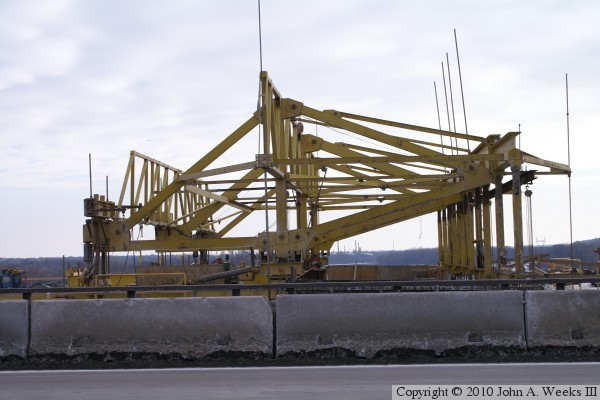

The photo above is looking southeast towards one of the form travelers. The
photo below is looking southwest towards the same machine. There is only
one machine remaining on this span. It is working to fill in the final
gap in the bridge span. The K-blocks that are stacked on the bridge are used
as weight to hold down the section on the west side of the gap so it lines
up with the east side of the gap.
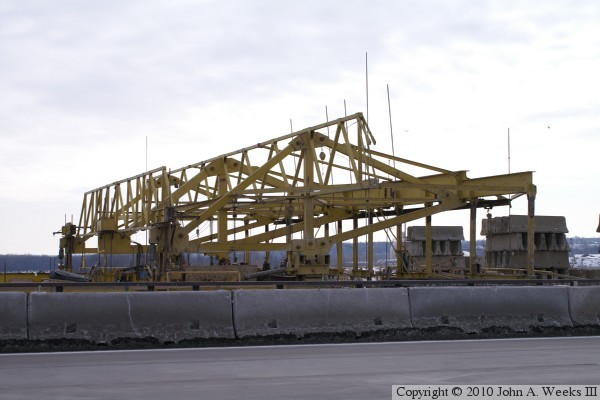
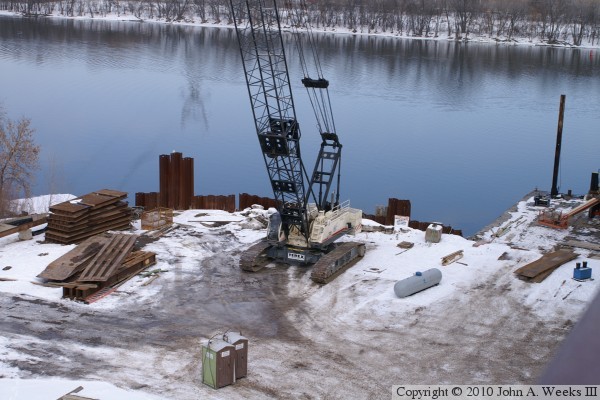
The photo above is a view of the temporary dock that was built on the west
bank of the Mississippi River just upstream of the bridge site. The vantage
point is the sidewalk on the upriver side of the westbound bridge span. Note
the cable loops on top of the portable toilets. These loops allow the toilets
to be lifted onto the bridge by cranes to be placed near the active worksites.
The photo below is the north side of the west bridge abutment. It is
disappointing to see the water and salt stains on the faux stonework. One
would think that a modern bridge design would have a better system to
manage runoff water.

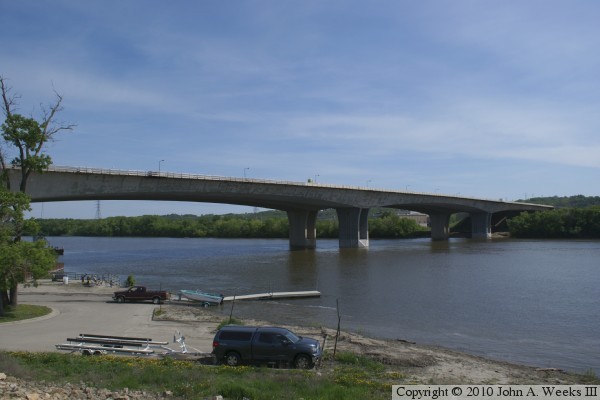
These two photos, and the two that follow, are views from May 16, 2010. The
main bridge spans have been joined, and the form travelers have been
disassembled and removed. The photo above is looking northeast towards the
downriver side of the main river spans. The photo below is looking east
along the south face of the bridge.


The photo above is a closer view of the western of the two main river spans.
The barges and cranes have been been removed, but the temporary dock (hidden
by the tree) is still in place. The photo below is the westernmost bridge
span. The steel falsework has been removed.
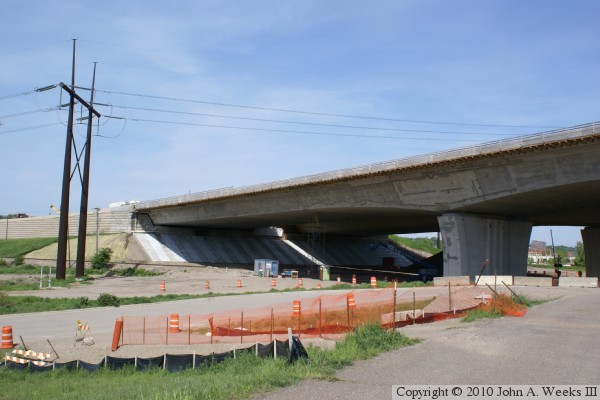
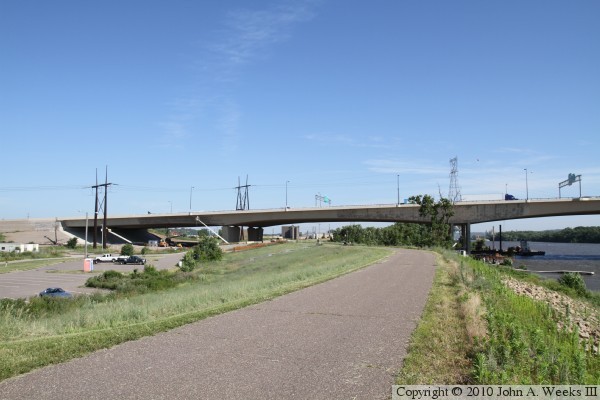
These two photos, and the two that follow, are views from July 1, 2010, the
day that the eastbound bridge span opened to traffic. The photo above is
looking north along the bicycle trail on the levee near the west bank of the
Mississippi River. The two smaller spans on the west end of the bridge are
visible, as well as part of one of the two larger main river spans. The photo
below is a closer view of the westernmost span and the west bridge abutment.
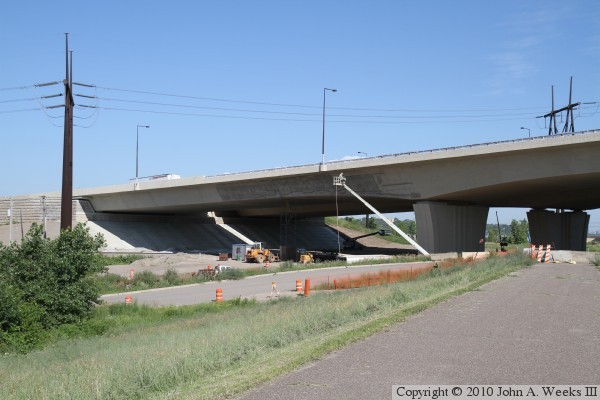
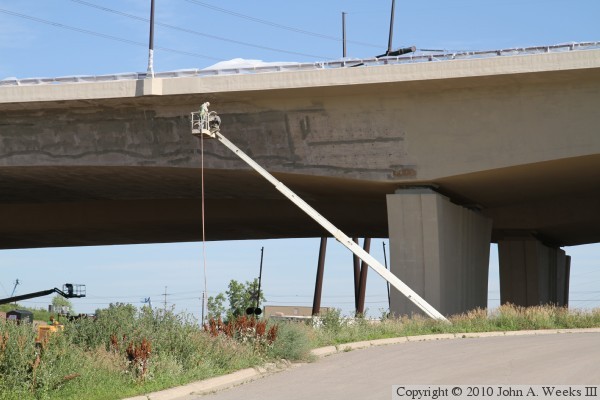
These two photos are closer views of construction work that is in progress
on the day that the eastbound bridge span opened. The structural work is
completed, but large areas of the bridge are in need of paint.
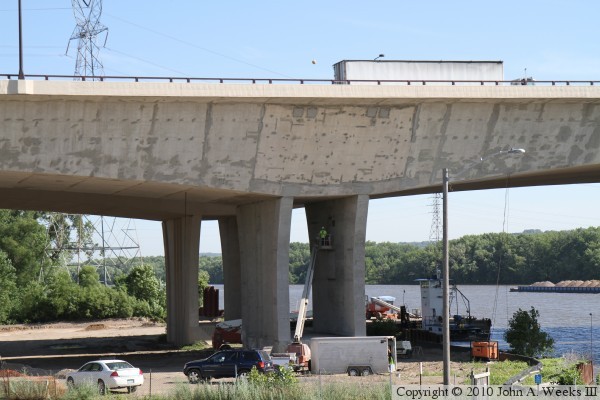
|



















































